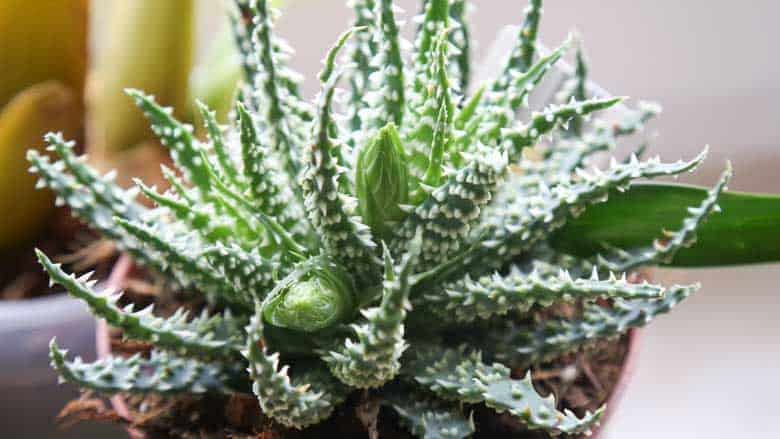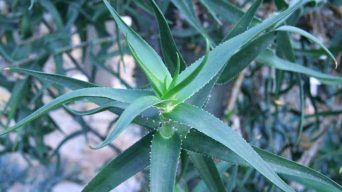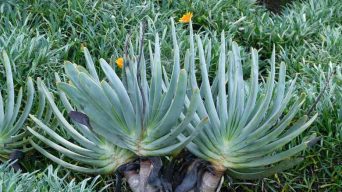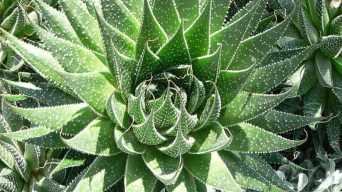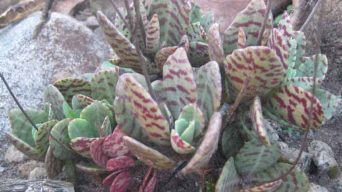There are many reasons to grow the Aloe humilis (Spider Aloe) in your home or garden.
This plant is a small and easy-to-care-for succulent that will thrive in many environments.
It’s perfect if you don’t have much time to take care of it, as it’s a very resilient plant, and it will survive most of your mistakes.
This article will teach you how to care for Spider Aloe and provide tips on propagating your plant so you can grow your own!
Overview
| Family: | Asphodelaceae |
| Genus: | Aloe |
| Botanical Name: | Aloe humilis |
| Synonyms: | Haworthia ferox, Haworthia fasciata var. armata, Catevala humilis, Aloe virens var. macilenta, Aloe virens, Aloe verrucosospinosa, Aloe tuberculata, Aloe subtuberculata, Aloe suberecta, Aloe perfoliata var. suberecta, Aloe perfoliata var. humilis, Aloe macilenta, Aloe incurva, Aloe humilis var. subtuberculata, Aloe humilis var. suberecta, Aloe humilis var. macilenta, Aloe humilis var. incurvata, Aloe humilis var. echinata, Aloe humilis var. candollei, Aloe humilis var. acuminata, Aloe echinata , Aloe acuminata var. major, Aloe acuminata |
| Common Names: | Spider Aloe, Blue Dwarf Aloe, Dwarf Hedgehog Aloe, Hedgehog Aloe |
| Origin: | South Africa’s Cape Province |
| USDA Hardiness Zones: | 10 – 13 |
| Size: | 8 inches (20 cm) in diameter and leaves up to 4.8 inches (12 cm) long and 0.7 inches (1.8 cm) wide |
| Sun Exposure: | Full sun to partial shade |
| Water Needs: | Water thoroughly but infrequently |
| Soil Type: | Well-draining soil |
| Temperature: | 68° to 80° F (20 – 27°C)) during the day and 50° – 70° F (10 – 21°C) at night |
| Humidity Levels: | 40% |
Aloe humilis is a succulent plant that persists year after year that belongs to the Asphodelaceae family, and is native to South Africa.
It is a small succulent that forms clusters of stemless rosettes of pale blue-green leaves with soft spines on the margins.
It is a rosette-shaped succulent that grows up to 8 inches (20 cm) in diameter.
The leaves are triangular and can grow up to 4.8 inches (12 cm) long and 0.7 inches (1.8 cm) wide.
This succulent species flowers in late winter to early spring atop a 14-inch (35 cm) tall stem bearing tubular, red flowers about 2 inches (5 cm) long.
The Aloe humilis is commonly known as:
- Spider Aloe
- Blue Dwarf Aloe
- Dwarf Hedgehog Aloe
- Hedgehog Aloe
How To Care for Aloe Humilis (Spider Aloe)
Aloe humilis care is effortless and straightforward.
Below you’ll find the essential information you need to know about caring for Aloe humilis ‘Spider Aloe’.
Sun Exposure & Light Requirements
Aloe Humilis ‘Spider Aloe’ is a succulent plant that requires full sun. Still, your Spider Plant succulents will also do well in partial shade.
Indoors, they thrive with bright light, especially during the summer when your other plants struggle to get enough sunlight.
A south-facing window is your best location if your goal is to keep your succulent plants indoors, but a large west- or east-facing window will also do the trick.
Remember that this Aloe variety requires at least 6 to 8 hours of sunlight daily.
If your succulents are under-lit, your leaves will droop, and your plant may suffer from yellowing or brown spotting.
Outdoors provide your plants with light shade, especially during the hottest parts of the day.
Though your plant can handle a little midday sun, it will need protection from intense direct sunlight so your succulent leaves won’t burn and your plant won’t be stressed.
Watering Requirements
The Aloe humilis ‘Spider Aloe’ is a highly drought-resistant plant. That being said, it still needs water regularly.
Let the soil dry out before watering your succulent deeply and thoroughly so your Humilis does not suffer from overwatering.
How much your Spider Aloe will need to be watered will depend on your environment.
If you live in a dry place, your plant will need less water than near the ocean.
An excellent way to figure out your watering schedule is to check your plant’s soil with your finger every week. If your plant feels dry and the first bit of your finger goes in easily, then you know that your succulent needs water.
Soil Requirements
The Aloe humilis ‘Spider Aloe’ grows in a wide range of soils but prefers sandy soil. They require well-drained soil and don’t like wet soil, especially over the winter period.
Aloe species grow best in cactus soil or succulent soil mix. You must ensure your potting medium drains quickly to avoid root rot, which is the most common reason succulents succumb outdoors.
Place a drainage layer of stones or broken pots in your pot to ensure your potting medium drains quickly.
You may want to add perlite or pumice if your heavy potting medium doesn’t drain well.
Crushed granite is also a good drainage medium for your Aloe humilis ‘Spider Aloe’ plant. It’s an inert material that won’t decompose over time like organic matter.
Temperature and Humidity
The Aloe humilis ‘Spider Aloe’ is a succulent plant, which means it will like the environment to be hot and dry.
Aloe loves heat and sunshine; as long as you provide temperatures of 68° to 80° Fahrenheit (20 – 27°C) with your nights at 50° – 70° Fahrenheit (10 – 21°C), your Aloe humilis ‘Spider Aloe’ will be happy.
It also needs around 40% relative humidity. When your plant has been in your home for a while, you will notice that your Aloe humilis ‘Spider Aloe’ starts to shrink and go brown. This means your humidity level is probably too low.
Fertilizing
The Aloe humilis ‘Spider Aloe’ plant is easy to maintain and does not require much fertilizer.
However, you can fertilize your plant once a month during the growing season with a diluted fertilizer at half strength to boost your plant growth.
But be careful not to fertilize too much, as this can injure your succulents, causing the leaves to become brown and rotten.
Fertilize your Aloe humilis ‘Spider Aloe’ plant as follows:
- Use a diluted fertilizer at half-strength.
- Apply the fertilizer evenly throughout your plant’s soil.
- Water your Aloe humilis ‘Spider Aloe’ plant well after applying the fertilizer to allow your plant to absorb the nutrients.
Potting and Repotting
Aloe humilis plants are slow-growing and rarely need repotting.
Repot them in the spring in a container about one to two inches larger than the current pot (So you don’t damage your roots).
Good drainage is essential to the survival of your Aloe humilis.
Over time, you’ll see your plant develop a “sunken” look and roots that are too long and messy, which can lead to rot. Just repot it in a container with drainage holes, and you’re back in business.
An Aloe that has outgrown its container will need to be transplanted into a pot only one size larger, not two or three times the size.
Pruning
Usually, you don’t need to prune your Aloe humilis plant, but you may want to remove any dead leaves or old stems to improve its appearance.
Pruning your Aloe humilis ‘Spider Aloe’ may also encourage it to grow bigger and fuller.
In addition to trimming away dead leaves, you should also periodically trim the stem of your aloe plant so it does not become too leggy.
Aloe plants will develop large bulbs and more offsets if you trim your Aloe occasionally. Still, there is only a need to prune it if it looks unkempt.
Pests and Diseases
Overall, your Aloe Humilis (Spider Aloe) succulent is pest and disease resistant.
The only pests you need to watch out for are the common ones that plague other plants in your home or garden, such as mealybugs, scale, and aphids.
These can easily be picked off your plant by hand if your plant is large enough.
With a strong spray from your garden hose, you can remove larger pests like spider mites and other soft-bodied insects off your plant.
The most common disease your Aloe humilis can get is Root Rot caused by overwatering your succulents. Your plant will appear to be wilting, and your leaves may discolor or wilt away from your main stem.
If you find these signs on your succulent, you should prune your plant at the base below the crown. After doing this, your plant should start to recover immediately, and your wilting leaves will return.
A more severe fungus your plant can get is Powdery Mildew. This causes white powdery spots on your leaves, killing the affected part.
Luckily this does not kill your plant as a whole, but it can stunt your succulent growth if you do not treat your plant.
To get rid of Powdery Mildew, you should also prune your infected leaves and stems at their bases. Then your leaves will come back without the white spots.
How to Care for Aloe Humilis (Spider Aloe) in Winter
Aloe humilis ‘Spider Aloe’ winter care is quite simple. All you need to do is ensure your succulent plant has the proper water and sunlight.
Light Requirements for Spider Aloe in Winter
The Aloe humilis ‘Spider Aloe’ succulent prefers partial sun exposure during winter.
There must be just enough light to get your plant through the cold season but not too much light that your plant will burn up or get attacked by pests.
A window with southern exposure would be perfect so your succulent can enjoy some sunshine in your home throughout winter.
Water Requirements for Spider Aloe in Winter
The ‘Spider Aloe’ succulent plant loves to be watered. But it would be best to let your plant dry out completely before watering it again.
If your succulent grows near a window, the sun will also help your plants absorb moisture from the air. You don’t have to worry about watering your plants as much as you do during warmer seasons.
Water your succulents thoroughly every 2-3 weeks until spring arrives. Be sure not to overwater your Spider Aloe because rot may occur if your plants get too moist!
How To Propagate Aloe Humilis (Spider Aloe)
Aloe humilis ‘Spider Aloe’ can be easily propagated by leaf cuttings or offsets.
How to Propagate Aloe Humilis (Spider Aloe) by Leaf Cuttings
Pick a leaf at least 6 inches long to propagate your plant by leaf cuttings. Cut the leaf off your plant just below the last point on the stem.
Allow your cuttings to callous over before putting them in soil by letting the cut end harden for 2-3 days. Using well-drained soil, you can set your cuttings directly into planting pots.
It should take about three weeks for your Aloe Humilis to root, so keep your new plant in bright light and water only when the soil feels completely dry.
Eventually, your cutting will have rooted, and you can then pot it in regular soil to create a more stable growing environment.
How to Propagate Aloe Humilis (Spider Aloe) by Offsets
The best way to propagate your Aloe humilis ‘Spider Aloe’ succulent plant is by offsets.
To propagate your Aloe humilis ‘Spider Aloe’ by offsets, you want to let your plant form offsets on its own.
Aloe Humilis will naturally produce new plants around the edges of your main plant. You can then separate them from the mother plant and pot them in their own containers.
To separate your offsets, remove them by twisting the plant while pulling gently away. It is essential to try and keep your offsets intact without damaging the roots or breaking any leaves off.
Pot your new plants in soil that drains well but retains moisture, just like you did for your Aloe humilis ‘Spider Aloe’ mother plant.
Is the Aloe Humilis (Spider Aloe) Toxic?
The Aloe Humilis (Spider Aloe) plant is safe for any household. It does not pose any health risks or dangerous toxicity.
To be safe, however, you should always wash your hands after working with the plant.
Final Thoughts
Aloe Humilis, also known as the Spider Aloe, is an exceptionally straightforward succulent to propagate and cultivate, which renders it an ideal choice for both novices and seasoned plant enthusiasts alike.
Also, it’s very tolerant of neglect and improper care, so your likelihood of killing this plant is pretty low.
So, if you’re looking for an easy way to add color to your home or office space without any maintenance responsibilities, this might be the perfect option!

